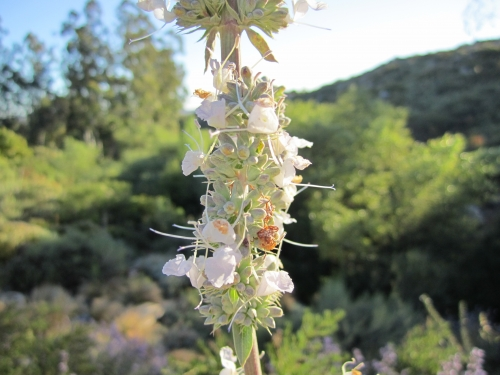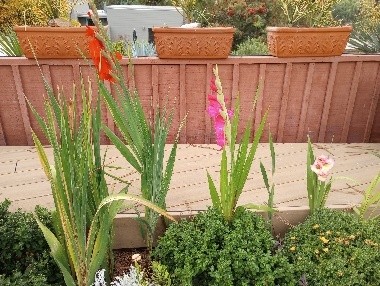SHARING SECRETS: Favorite Wildflower In Bloom Now
- k-england
- May 31
- 7 min read
Edited by Cathy Tylka, for Let’s Talk Plants! June 2025.

This month’s question:
Do you have a favorite flower, plant or tree in your garden, neighborhood, San Diego County, or in the world that is your favorite WILDFLOWER and is in bloom now?

Denise of 92083 shared…
... I have lots of “favorites” when talking wildflowers. Right now, it would have to be Verbena lilacina, ‘De La Mina’. It’s in full bloom now and my yard smells amazing.
They’re a mounding perennial that grows 3’-4’ tall and wide. Drought tolerant. I shear it lightly in early fall to keep a denser shape. Propagate in spring using soft wood cuttings.
…then she recounts…
”Silly me. The verbena is a native not a wildflower. 😁😁 I’ll send another response...”
Cathy responded,
“I was so excited because it’s amazing, it is both!”
So happy because Denise wanted to try again! And this time she picked Ratibida columbaria, Mexican Hat.

In my zone, Vista, it is a drought tolerant perennial. It grows about 3’ high, summer blooming, is self-seeding and the butterflies love it.
They are growing in my yard. I have transplanted some to other areas of my yard and I’ve shared them with friends.
DeDe of 92037 reports…

...Nasturtiums. I used to see them in an alley when walking my dog and I loved them. I bought some to put on my hillside but they didn’t last long. Tried again last year and just enjoyed the color. They eventually withered and died. But this year was a wonderful surprise! The flowers are blooming in so many places that were never planted. Feels magical.
Chris adds to the responses…
...Daisies are nature's gift when you live in rural NY. Spring rains water them abundantly, and they proliferate. Night blooming jasmine does best with summer temperatures and requires vigilance to eradicate snails, which will decimate them. I lived in NE US for my first 24 years, not helping my relatives garden, but thoroughly appreciating the results!
I hope to buy and plant a replacement night blooming jasmine in a pot to prolong its life span and keep the snails away.
I've also attached: (Left) a photo of my first go last year at gladiolas, pictured within my deck's sunken garden; and (Right) my newly purchased wooden planter boxes, within which I planted a dinner plate dahlia in each box.
Many thanks! Reaching back within my photos has been fun for me too.
SSJ65 talks to us about…

...My Douglas iris caught me by surprise last week ~ always amazing when it opens! It was actually out of bloom when I got your message.
It is leftover in a pot from our San Diego Floral Association native plant display at the Fair (How the West was Fun) -- how many years ago? Pre-pandemic. (Yep. It was 2017.) It is in 60% shade, and it didn't do very well this year. It probably does need splitting!
Gwen Calderon of 92024…
... My Abutilon Palmieri has been blooming for months now, and I love the yellow and orange versions, can’t decide which one is my favorite! And then the silvery leaves! Quite, quite stunning!

The globe mallows are in clumpy clay soil, I water them about once every two weeks, inground drip irrigation. I if it gets hot and the leaves droop, I hand water a bit more.

The beach asters erigeron glaucus are glorious when in bloom!

Same soil and all of these are in full sun!
Joe Fuentes and Sarah Archibald simply say…
Matilija poppy, (Romneya).

And Susan Reed of 92028 shares…
... California poppies.

Julie Frank of 92029 provides this answer…
... I love these bright yellow daisies. One because these plants always seem to be blooming and two because yellow is my favorite color! This was taken at Felicita County Park where I am lucky enough to be able to walk in almost every day!

Barb Huntington speaks up for…
...Love hummingbird sage and white sage —both blooming now!


Alyse Ford of 92126, recommends…
... Calendulas started growing in my backyard Last year, after I took some seeds from my neighbors’ plants and scattered them in my yard. I just love the yellow color. Here’s a picture of my front yard. I’ve never had a plan for my yard. I just plant what I feel like at the moment. It’s fairly drought resistant.

Ida Rigby of 92064 participates with...

...My favorite flower or plant is different every time I go into the garden; so, I decided to simplify matters by sending in the last flower that impelled me to return into the house to get my camera, not a bad criterion.
It’s Mme. Isaac Pereire (1881) reputedly still the most fragrant of roses. I have often pegged roses to create a fountain or arched climbers to get blooms all along the cane. In this case the monster cane (own root rose) grew into the path, so I simply tied one end to the chicken wire cage surrounding it. The result (early May) ...

...was this wreath of roses. It’s just right of center in the general view of the back garden where my heirloom sweet peas (in the family for over 60 years) have taken over the strawberry patch.
My favorite wildflower is the blue-eyed grass, which is now officially our county flower. It is blooming in the garden right now (early May).

Karen England of 92084 loves...

...Sweet Alyssum! It’s an herb (Yes! More on that later...) that I have grown for 25 years but never planted. I am in my mid 60s and as a youngster I remember it growing in my grandmother’s garden in Sierra Madre, CA and she never planted anything. Many people call it a weed (as it is with so many herbs that are called weeds; dandelion, mustard, etc...) but I have always called it a wildflower. I know it has a CAL-IPC (California Invasive Plant Council) rating of Limited. (There are only five total CAL-IPC ratings; High, Moderate, Limited, Alert and Watch. Limited means “These species are invasive but their ecological impacts are minor on a statewide level or there was not enough information to justify a higher score. Their reproductive biology and other attributes result in low to moderate rates of invasiveness. Ecological amplitude and distribution are generally limited, but these species may be locally persistent and problematic.”)
Have you ever smelled the fragrance of a Sweet Alyssum patch wafting up in a morning breeze? It is glorious.
“But Karen,” I hear you saying, “why is it an herb?”
So glad you asked!

“Sweet Alyssum, Lobularia maritima, is a member of the Brassicaceae family and is widely known for its ornamental value. However, what is less known about this plant is its potent medicinal properties that have been used for centuries.” - The Healing Properties Of Sweet Alyssum: Medicinal Uses Revealed | ShunCy
If any of you shop for edible flowers at Specialty Produce in San Diego, you can buy from them Sweet Alyssum flowers for cooking! Some of you would never pay money for this ubiquitous weed but there is a Specialty Produce customer, a restaurant in Oceanside, serving Sweet Alyssum flowers on their menu as of the 25th of May 2025. Ooh la la!
Specialty Produce describes the alyssum flavor as “the small blooms emit a rich, honeyed aroma and have an intense, peppery flavor with bitter-sweet and earthy undertones.” They list the Nutritional Value of Alyssum thusly, “Alyssum flowers and leaves contain many of the same nutrients as other members of the Brassicaceae family. Brassicas contain high levels of vitamins A and E to support immunity, reproduction, and vision, and vitamin C, a nutrient vital for maintaining blood vessels, collagen, cartilage, and bones. The greens are also known to contain high levels of folate, iron, potassium, and phosphorus, nutrients that support tissue and cell repair in the body. Alyssum flowers have traditionally been used to treat various ailments, including colds, coughs, and abdominal pains. The flowers act as a natural diuretic and are used in some homeopathic remedies to prevent excessive water retention, edema, and kidney disease. Historically, Alyssum has also been used in Spain as a treatment for gonorrhea and scurvy.”
A search made through the Specialty Produce website for Sweet Alyssum recipes resulted in this Steamed Mussels with Alyssum and Tomato Fennel Relish - Delicious Living
Cathy Tylka of 92026 comes up with …
...Desert Broom, Baccharis sarothroides. Belongs to the aster family. As some of you might know this is a native shrub that grows abundantly here in the southwest.
Per Wikipedia…
“Baccharis sarothroides is a North American species of flowering shrub known by the common names broom baccharis, desert broom, greasewood, rosin-bush and groundsel in English and ‘Escobar Amarga’ or ‘romerillo’ in Spanish. This is a spreading, woody shrub usually sticky with glandular secretions along the primarily leafless green stems. The small, thick leaves are a few centimeters long and are absent much of the year, giving the shrub a spindly, twiggy appearance. It flowers abundantly with tiny green blooms on separate male and female plants.
Native to the Sonoran Desert of northwestern Mexico (Baja California, Baja California Sur, Sinaloa, Sonora) and the Southwestern United States (southern California, Arizona, New Mexico, western Texas), it is common in gravelly dry soils and disturbed areas.
This plant is in some acreage near my home in Hidden Meadows and I enjoy seeing it on a regular basis.

The Ceanothus, also known as Mountain Lilac blooms in April and May.
Per the Spruce, “If you're looking for a vibrant splash of bright blue in your garden, you can't go wrong with a California lilac (Ceanothus). There are around fifty pollinator-friendly, flowering, drought-tolerant shrub species in the Ceanothus genus. Most are evergreens, but there are also some deciduous options. They can be free-standing or used as border plants or informal hedges. Many gardeners choose to train certain cultivars to climb walls, fences, or even door arches. Plant California lilacs in spring with full sun. These plants are drought-tolerant once established. Read on for our growing guide.
Question for Sharing Secrets for next month…
Do you have something in your yard that you purchased, or inherited, or got out of the refuse, or got from a thrift or garage sale, that you love how you got to use it in your garden to promote something that is grown near, around, with or inside of your lovely place?
It can be as simple as the plastic that you purchase strawberries in and use for another planting adventure, or a piece from your bedroom, that has been changed into a way to help vines, roses, grapes, etc. to grow. Basically, I’m saying anything received or purchased. Tell me how you use it to complement your garden. If you see it somewhere else, possibly in someone else’s garden, that’s great too!









